
The Marquesas Islands are a group of volcanic islands in French Polynesia, an overseas collectivity of France in the southern Pacific Ocean. Their highest point is the peak of Mount Oave on Ua Pou island, at 1,230 m (4,035 ft) above sea level.
Marquesan is a collection of East-Central Polynesian dialects, of the Marquesic group, spoken in the Marquesas Islands of French Polynesia. They are usually classified into two groups, North Marquesan and South Marquesan, roughly along geographic lines.

With its 320 square kilometres, Hiva Oa is the second largest island in the Marquesas Islands, in French Polynesia, an overseas territory of France in the Pacific Ocean. Located at 9 45' south latitude and 139 W longitude, it is the largest island of the southern Marquesas group. Around 2,200 people reside on the island. A volcano, Temetiu, is Hiva Oa's highest point with 1,200 metres.
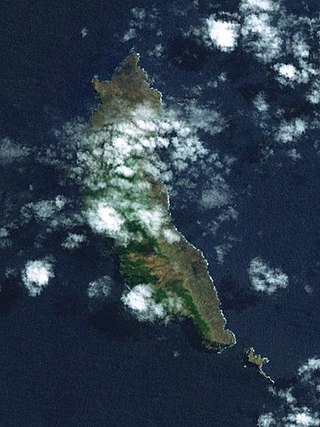
Mohotani is an uninhabited island southeast of Hiva Oa and east of Tahuata in the southern Marquesas Islands. It has an area of 15 km2. Much of the island's sparse vegetation has been destroyed by feral goats and sheep, to the extent that following its rare rains, the sea around it is stained red from runoff. Early reports describes the island as fertile, with forest and fields. When Thor Heyerdahl visited the island in 1938, there were only a few goats and remains of deserted huts and villages.
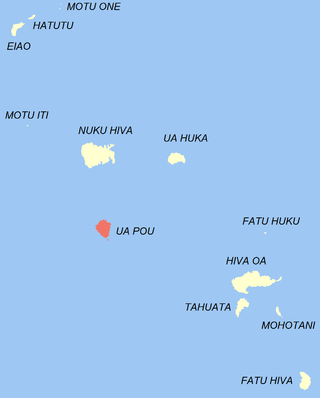
Ua Pou is the third largest of the Marquesas Islands, in French Polynesia, an overseas territory of France in the Pacific Ocean.

Hatutu is a small island approximately 3 km (2 mi.) northeast of Eiao in the northern Marquesas Islands. It is approximately 3 km from Eiao by a channel 50 meters deep. It was also known by the names Hancock, Chanal, Langdon, and Nexsen
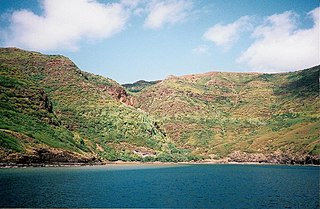
Eiao is the largest of the extreme northwestern Marquesas Islands. The island is uninhabited, but is administratively part of the commune (municipality) of Nuku-Hiva, itself in the administrative subdivision of the Marquesas Islands.
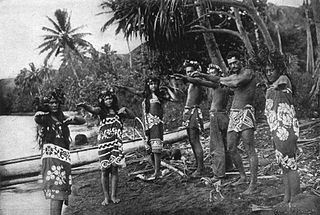
The Marquesas Islands were colonized by seafaring Polynesians as early as 300 AD, thought to originate from Tonga and the Samoan Islands. The dense population was concentrated in the narrow valleys and consisted of warring tribes.

Tahuata is the smallest of the inhabited Marquesas Islands, in French Polynesia, an overseas territory of France in the Pacific Ocean. It is located 4 km (2.5 mi.) to the south of the western end of Hiva Oa, across the Canal du Bordelais, called Ha‘ava in Marquesan.

Ua Huka is one of the Marquesas Islands, in French Polynesia, an overseas territory of France in the Pacific Ocean. It is situated in the northern group of the archipelago, approximately 25 mi (40 km) to the east of Nuku Hiva, at 8°54′S139°33′W.

Notre Dame Cathedral is a 20th-century church that serves as the cathedral of the Roman Catholic Diocese of Taiohae or Tefenuaenata. It is located in the Meau Valley near the capital centre on the island of Nuku Hiva.

The conquered lorikeet is a species of parrot that became extinct 700–1300 years ago. It lived in islands of Polynesia. David Steadman and Marie Zarriello wrote its species description in 1987.
The Marquesan monarch is a species of bird in the family Monarchidae. It is endemic to French Polynesia. Its natural habitats are subtropical or tropical dry forest, subtropical or tropical moist lowland forest, and subtropical or tropical moist montane forest. It is threatened by habitat loss.
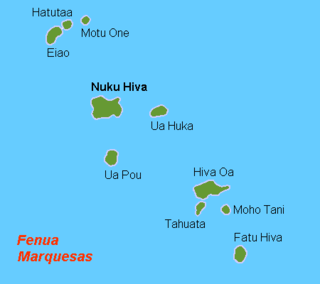
Nuku Hiva is the largest of the Marquesas Islands in French Polynesia, an overseas country of France in the Pacific Ocean. It was formerly also known as Île Marchand and Madison Island.
Joseph Kaiha is a politician of the Marquesas Islands in French Polynesia. He has been the mayor of the island of Ua Pou since 2001. He was Minister of Culture from 2008 to 2009, and founder and first president of the Marquesas Island Community (Codim).
There have been changing views about initial Polynesian discovery and settlement of Hawaii, beginning with Abraham Fornander in the late 19th century and continuing through early archaeological investigations of the mid-20th century. There is no definitive date for the Polynesian discovery of Hawaii. Through the use of more advanced radiocarbon methods, taxonomic identification of samples, and stratigraphic archaeology, during the 2000s the consensus was established that the first arrived in Kauai sometime around 1000 AD, and in Oahu sometime between 1100 AD and 1200 AD. However, with more testing and refined samples, including chronologically tracing settlements in Society Islands and the Marquesas, two archipelagoes which have long been considered to be the immediate source regions for the first Polynesian voyagers to Hawaii, it has been concluded that the settlement of the Hawaiian Islands took place around 1219 to 1266 AD, with the paleo-environmental evidence of agriculture indicating the Ancient Hawaiian population to have peaked around 1450 AD around 140,000 to 200,000.

The Marquesan Dog or Marquesas Islands Dog is an extinct breed of dog from the Marquesas Islands. Similar to other strains of Polynesian dogs, it was introduced to the Marquesas by the ancestors of the Polynesian people during their migrations. Serving as tribal totems and religious symbols, they were sometimes consumed as meat although less frequently than in other parts of the Pacific because of their scarcity. These native dogs are thought to have become extinct before the arrival of Europeans, who did not record their presence on the islands. Petroglyphic representations of dogs and the archaeological remains of dog bones and burials are the only evidence that the breed ever existed. Modern dog populations on the island are the descendants of foreign breeds later reintroduced in the 19th century as companions for European settlers.
Libythea collenettei, the Marquesan snout butterfly, is a species of Nymphalid butterfly in the subfamily Libytheinae. The species was first described by Edward Bagnall Poulton and Norman Denbigh Riley in 1923. The specific name honours its original collector, Cyril Leslie Collenette, a member of the 1925 St George Expedition to French Polynesia. It is endemic to French Polynesia, L. collenettei is the only species of butterfly endemic to the Marquesas Islands.














